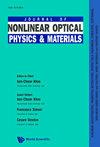Constructing hierarchical porous structure in microsized silicon/carbon nanotubes composite anode with LiF-rich solid-electrolyte interfaces for highly stable lithium-ion batteries
IF 2.3
4区 物理与天体物理
Q2 OPTICS
引用次数: 2
Abstract
Lithium-ion batteries (LIBs) with silicon microparticle anodes provide a high capacity, low cost, low environmental impact, and ease of production. However, the rapid capacity degradation and low Coulombic efficiency (CE) are impediments to their further development and commercialization, which are mainly caused by large volume variation and unstable solid–electrolyte interface (SEI) of silicon. To break this bottleneck, here, we demonstrate that designing silicon microparticles with nanoporous structure (PSi) and confining the PSi in the carbon nanotube (CNT) segregated network can effectively suppress the volume expansion of silicon, enabling the fabrication of high-performance electrodes. The rate capability and cycling performance of the electrode are further improved by creating a hierarchical open porous structure for the PSi-CNT composite anodes via freeze drying. In addition, the mixTHF electrolyte was employed to get a thin and uniform SEI, which can reduce the breakage of SEI during cycling and improve the CE and stability of the LIBs. As a result, the PSi-CNT composite anode delivers a high specific capacity of 3210.1 mAh g−1 at 1/15 °C rate and an initial Coulombic efficiency of 87.3%. After 100 cycles, the capacity could be maintained at over 2000 mAh g−1 with 99.5% CE. In addition, hierarchical porous structured PSi-CNT composites exhibit excellent rate performance, the specific capacity could reach 2264.5 mAh g−1 at 5 °C rate. The work suggests several effective solutions that could be used to facilitate the future commercialization of silicon anodes.在高稳定性锂离子电池中构建具有富liff固-电解质界面的微尺寸硅/碳纳米管复合阳极层次化多孔结构
具有硅微粒阳极的锂离子电池(lib)具有高容量、低成本、低环境影响和易于生产的特点。然而,由于硅的体积变化大、固液界面不稳定,导致容量退化快、库仑效率低,阻碍了其进一步发展和商业化。为了打破这一瓶颈,我们证明了设计具有纳米孔结构(PSi)的硅微粒并将PSi限制在碳纳米管(CNT)隔离网络中可以有效抑制硅的体积膨胀,从而实现高性能电极的制造。通过冷冻干燥为PSi-CNT复合阳极创建分层开放多孔结构,进一步提高了电极的速率能力和循环性能。此外,采用混合thf电解液制备了薄而均匀的SEI,减少了SEI在循环过程中的断裂,提高了lib的CE和稳定性。因此,PSi-CNT复合阳极在1/15°C的速率下具有3210.1 mAh g - 1的高比容量和87.3%的初始库仑效率。经过100次循环后,电池容量可保持在2000 mAh g−1以上,CE为99.5%。此外,层次化多孔结构PSi-CNT复合材料表现出优异的倍率性能,在5°C倍率下比容量可达到2264.5 mAh g−1。这项工作提出了几种有效的解决方案,可用于促进硅阳极的未来商业化。
本文章由计算机程序翻译,如有差异,请以英文原文为准。
求助全文
约1分钟内获得全文
求助全文
来源期刊
CiteScore
3.00
自引率
48.10%
发文量
53
审稿时长
3 months
期刊介绍:
This journal is devoted to the rapidly advancing research and development in the field of nonlinear interactions of light with matter. Topics of interest include, but are not limited to, nonlinear optical materials, metamaterials and plasmonics, nano-photonic structures, stimulated scatterings, harmonic generations, wave mixing, real time holography, guided waves and solitons, bistabilities, instabilities and nonlinear dynamics, and their applications in laser and coherent lightwave amplification, guiding, switching, modulation, communication and information processing. Original papers, comprehensive reviews and rapid communications reporting original theories and observations are sought for in these and related areas. This journal will also publish proceedings of important international meetings and workshops. It is intended for graduate students, scientists and researchers in academic, industrial and government research institutions.

 求助内容:
求助内容: 应助结果提醒方式:
应助结果提醒方式:


